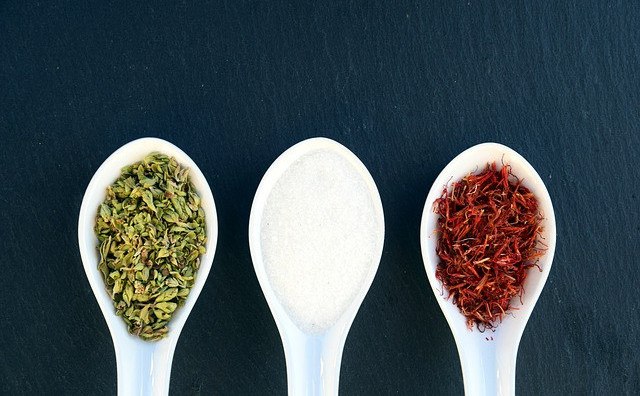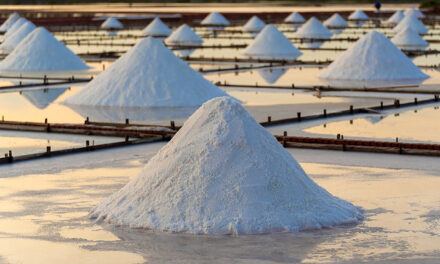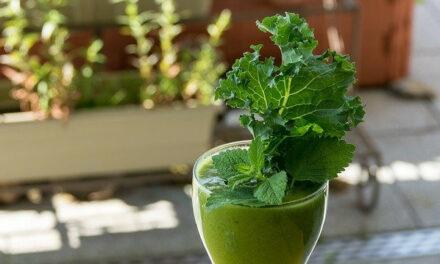If you are looking for an ideal white salt alternative, then red salt is always there to rescue you with some health advantages. Here we dig into the relationship between Red Salt and Diabetes, to address – Is Red Salt Good For Diabetics?
Let’s define red salt first before discussing how red salt affects diabetes…
What is Red Salt?
Red salt is an unrefined sea salt produced by water evaporation from the Pacific Ocean.
The salt is produced in Hawaii, where it collects deposits of iron oxide (clay) from volcanic clay known as Alaea. The result is a beautiful rust red colour with an exquisite flavour that is not too strong and not too subtle.
The high iron content in the volcanic clay adds beneficial nutrients and imparts a characteristic red colour to the salt.
Red Salt can be used just like any other culinary salt on beef, chicken, fish, eggs, vegetables and even desserts such as chocolate ice cream.
Let’s look into red salt nutrition now… Shall we?
Is Red Salt Healthy?
Red salt is healthy and has a lot of benefits. The following points highlight its significance,
- Maintaining pH Level
Red salt is healthy because it is a complete form of salt, which means it provides many more minerals than traditional salts.
This salt can balance the body’s pH level.
It also helps in neurological function and regulates hydration levels.
- Respiratory Benefits
Red salt is a developed salt changed with iron oxide. It’s used to treat congestion or blockages in the respiratory tract or infections resulting from weather aberrations.
Consuming red salt may also help promote good health and lung capacity.
- Helps with sleep
To get a good sleep at night, you need to have the proper relaxation and physical movement. Hence, you must have a compact amount of salt during your evening time.
This will help lower blood pressure and result in peaceful sleeping time, which people of different age groups are looking for nowadays.
If you’re struggling with sleep and looking for a natural remedy, red salt could help you with that!
- Healing Properties
Red salt has three main ingredients that help in reducing early ageing, namely: Magnesium, Calcium, and Iron. These elements are not found naturally in the usual salt, so it turns out to be the perfect remedy.
You can benefit from the red salt to prevent early ageing and regain your lost hair. It has natural properties, which can help you retain the essential oils of your hair and skin naturally.
If you want to stay young for a long time and are looking for a natural remedy, then red salt may help you.
- Anti-depression
The mineral content in red salt helps to maintain mood and mental stability.
Red salt helps keep a balanced body and mind, thereby reducing stress and depression to a great extent. This is especially effective for diabetics.
- Anti-inflammatory
Many of us might be suffering from joint pains and inflammations because of the unhealthy lifestyle we live nowadays. You can start consuming red salt as a supplement to treat such conditions.
It helps to reduce inflammation by regulating your body’s pH level. This way, it reduces pain while keeping inflammation at bay too.
- Maintains Blood Sugar level
The main reason that this type of salt will have such nutritional benefits for your body and for your mind is that it contains iron oxide, which gives the salt its unique red colour.
Iron oxide can actually help regulate blood sugar levels in your body, which means that if you suffer from diabetes or any other type of chronic disorder in which your blood sugar levels are not adequately regulated, then this type of salt can help you get back on track.
What’s In Red and Pink Salt – The Nutritional Content
Sodium is an electrolyte that plays an essential role in blood pressure regulation, fluid balance, and nerve signalling. The sodium in Himalayan salt is chemically identical to regular table salt, so it functions in precisely the same way in your body.
Himalayan salt contains up to 98% sodium chloride, while table salt contains around 97% sodium chloride, 2% calcium iodate, and 1% dextrose. Therefore, Himalayan salt can contribute a lot of sodium to your diet since it’s nearly pure sodium.
Red salt vs Pink Salt – What is The Difference?
Himalayan pink salt is a rock salt mined around the Himalayan mountains. It is also known as Himalayan crystal salt and has gained enormous popularity in recent years.
It has been said to boast several health benefits, including improved skin and better sleep. Contrary to what used to be a widespread belief, however, it is no more beneficial than any other kind of salt.
The pink-hued salt often called Himalayan salt, is typically mined near the Himalayas in Pakistan. While similar to table salt, pink Himalayan salt contains trace minerals like potassium and magnesium and is usually sold as larger crystals or a coarse ground salt.
White table salt gets its colour from additional processing that removes these minerals and may include an anti-caking agent and added iodine. However, neither is necessarily any better for you than the other.
If we compare red and pink salt, both have their own benefits and pros and cons. It all depends on the use and requirement of the user.
Red Salt vs Chinen Salt – What is The Difference?
The Chinen Salt is derived from a medicinal herb known as berberine or Berberis aristata.
The salt is preferred for its anti-bacterial properties and its ability to prevent fungus growth. Additionally, the salt quickly dissolves and retains both of these health benefits even after it dissolves.
Chinen Salt is a unique formulation of sodium chloride, potassium chloride and berberine.
The Berberine salt components come from the Berberis Aristata plant that grows in remote areas at high altitudes in the Himalayas mainly. Traditionally used for its health benefits, this Himalayan berry is considered one of Ayurveda’s most potent herbs.
Chinen Salt and Diabetes
Chinen salt is the natural alternative to traditional insulin many people use to manage type 2 diabetes. It’s in a category of herbal supplements, which are sometimes used in Traditional Chinese Medicine.
While there is no scientific evidence that Chinen salt will help treat diabetes, Chinese doctors have said it’s very effective for generations.
Japanese Chinen Salt
Japanese Chinen Salt is a unique, naturally-produced salt acquired by evaporating seawater. It is said to help treat diabetes and has even been suggested as an adequate substitute for diabetes medications due to its high mineral content.
This salt will add exceptional flavour to your favourite dishes while helping you maintain a healthy immune system, lower blood pressure and keep muscles functioning properly.
Himalayan Red Salt
Pure Himalayan Red Salt is said to help treat diabetes too.
This salt has been harvested from the Himalayas for many centuries and has been shown to have many nutritive properties. It can also be used in a Himalayan Salt Inhaler.
Red salt, which contains elements of red clay, is said to have many health benefits. It is thought by some to lower blood pressure, improve cardiovascular health and circulation, protect against bacteria, treat diabetes and even aid weight loss.
Modern science has yet to prove if red salt offers these benefits, but users seem convinced that it does.
Is Red Salt Good For Diabetics?
Red Salt has a lot of potential benefits, especially for people with diabetes. Following are some of them:
- Improves Appearance
Red alaea salt is similar to table salt in that it has a salty flavour and is used for cooking.
Like many other salts, it contains trace minerals, such as sodium and calcium, and iron oxide, which gives the salt its red colour.
The products used by the salt can be applied to your skin or inhaled.
The minerals contained in the product may be absorbed through your skin or lungs to promote toxin elimination and boost healing
- Lower Sodium Percentage
Red salt offers the same benefits as your standard table salt.
It’s actually less sodium content per serving, making it a good choice for those seeking to curb their sodium intake. It also is an excellent source of minerals as well is provides numerous health benefits.
Perhaps you have heard that alaea salt is a healthier alternative to traditional table salt. If so, you might be wondering if this means it’s truly safe for diabetics.
In short, the answer to that question is yes. You can feel free to add alaea salt to your home-cooked meals, but it’s not recommended that you use it on every meal and snack.
- Helps regulate Blood Pressure
Foods with a deep red colour, including Red Salt, are high in anthocyanins and other nutrients that support heart and brain health.
The benefits of these unique phytonutrients from red salt have gained recognition among experts and consumers alike, as mounting scientific evidence shows the benefits of eating healthy red foods like cherries, berries, grapes, pomegranates, tomatoes, and leafy greens.
The former will help develop the body’s natural ability to protect itself from disease and other health problems while providing the essential nutrients needed to maintain optimal health.
Red salt is a delicious way to get more beneficial phytonutrients into your diet.
- Rich source of dietary iron
Pure red alaea sea salt is an all-natural, unrefined, antioxidant-rich source of dietary iron. The amount of iron it adds to your diet depends on the amount of alaea you ingest.
While many people are not aware of this, most health experts agree that adult humans need iron from food sources to maintain their production of red blood cells.
If you have a deficiency in iron and begin supplementing with red alaea sea salt, you may notice some positive changes in your overall health and wellness.
- Taste and Texture
Hawaiian Red Alaea salt is simply the black lava salt of Hawaii, which makes it an excellent Hawaiian souvenir.
It has a colour that ranges from charcoal to dull reddish-brown, and it can be used for seasoning in place of regular salt. It is also precious in flavour and texture when used for grilling fish and meats.
How To Use Red Salt By Diabetics?
Red Salt is a popular ingredient in many cuisines, and it has numerous applications, both culinary and medicinal. Usually, extracting red salt is quite expensive—but that’s where things get interesting.
Researchers have found a way to extract the red salt from dried chillies at a low cost in recent years. The implications of this are immense; previously, red salt could only be extracted from seawater or dried marshes at prohibitive prices. Now it can be extracted on a large-scale basis using chilli peppers.
Red salt is famous in the Japanese diet. It has withstood the test of time because of its specific nutritional composition.
Red salt is usually mined, but it can also be hand-harvested exclusively on tidal flats. Like all salts, they should be consumed moderately as part of a healthy diet, including reducing sodium intake.
Mix a cup of Red Salt in a small container with coconut or olive oil, and use this salt scrub to treat your skin to a quick exfoliation.
The Red Salt does most of the work and is great for scrubbing the toughest dead skin cells away.
So, if you want to keep yourself protected from the adverse effects of white salt and its extra components, go for red salt seasoning. It will remove your excess weight and give you a toned body.
At the same time, it will improve your ability to fight against diseases by providing greater immunity to your body cells and tissues.
Conclusion
Red salt is known to provide relief from many illnesses. It enhances the functioning of your brain, increases blood flow and gastrointestinal tract, replenishes your cells and tissues, and removes toxins from your body.
Red salt can prevent diabetes by improving the insulin-secreting ability of the pancreas gland. It can also help prevent heart diseases and other cardiovascular disorders by reducing excessive cholesterol levels in your body and improving the functioning of your circulatory system.













